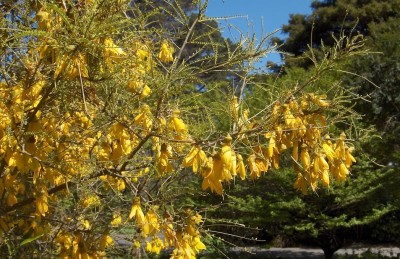Rata Tree
Rata trees, along with the pohutukawa, are one of the best known native trees in New Zealand. The rata and pohutukawa belong in the myrtle family of trees. Other members of this family include manuka, kanuka and swamp maire. There are two main types of rata, the northern and southern.
Rata trees have glossy dark green leaves and trunks that are often gnarled and twisted. However they are best known for their brilliant red flowers that appear in profusion from November to January, depending on location, and can be seen from some distance away. The trees tend to flower well only once every few years and seem to favour the high rainfall conditions of the West Coast. Native birds such as the tui, bellbird and kaka all benefit from the presence of rata trees in the forest.
Kōwhai Tree
The Kōwhai is one of the best known native trees in New Zealand and it’s our unofficial national flower.
Kōwhai grow from a seed in the ground to become a tree up to 25 metres high. It’s found throughout New Zealand in a diverse range of habitats from riparian forests, coastal cliff faces to inland grey scrub communities.
Kōwhai are best known for their brilliant yellow flowers that appear in profusion in Spring and stand out among the forest greenery.
Native birds such as the tui, bellbird, kākā and New Zealand pigeon/kererū/kūkū/kūkupa all benefit from kōwhai trees.
Ferns
Ferns are mostly a tropical group, and New Zealand has an unusually high number of species for a temperate country. We have about 200 species, ranging from ten-metre-high tree ferns to filmy ferns just 20 millimetres long. About 40 per cent of these species occur nowhere else in the world.
Ferns are typically found in moist, forested areas because they require lots of water. Ferns are abundant in all damp situations in New Zealand forests, forming the undergrowth beneath a dense canopy of evergreen trees. They are also found growing on tree trunks and branches and along stream banks. Some hardy species have adapted to other drier habitats such as coastal, alpine, urban and even desert locations.
The leaves of ferns are called fronds and when they are young they are tightly coiled into a tight spiral. This shape, called a ‘koru’ in Māori, is a popular motif in many New Zealand designs.
The Silver Fern or Ponga is a national symbol and is named for the silver underside of its fronds.
Black Beech (Tawhairauriki)
Black beech (Nothofagus solandri) are found in the lowland areas of the North Island and northern South Island.Beech trees flower in spring and are wind pollinated. After fertilisation, beech flowers produce seeds in the form of small winged nuts which fall in autumn.
The seeds rarely blow more than a few metres before falling to the forest floor where they germinate the following spring. The half light of the forest floor stunts the growth of seedlings until a mature tree falls and light floods in. Once established, a beech tree can grow over 30 metres tall and can live for more than 300 years.
Mānuka / Kāhikatoa
Mānuka or kāhikatoa (Leptospermum scoparium), called ‘tea tree’ by Captain Cook, is a rather variable plant ranging from flat creeping forms and small shrubs to tall trees (up to 10 m tall).
Although variable, all the forms of this species are unified by their sharp-tipped leaves, large, solitary white or pink-flushed flowers, with distinctive short, dark red stamens, and persistent greyish-white nut-like capsules. Mānuka / kāhikatoa plants are sometimes covered with sooty mould, a black fungus that feeds on the honeydew produced by scale insects.
Early settlers battled hard to clear their land and regarded mānuka / kāhikatoa as invasive shrubs that undid all of their hard work. Today however, these plants can act as an important tool for re-vegetating bare, eroded slopes. By creating shade and shelter from the wind, they provide an excellent nursery for other, slower growing native plants. Then, as these other plants get taller and overtop them, the mānuka / kāhikatoa die away as a result of being shaded.




